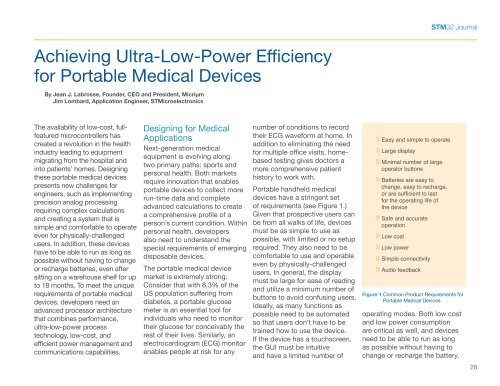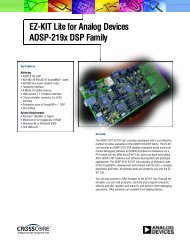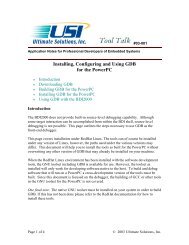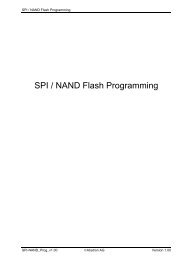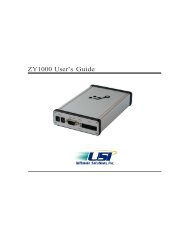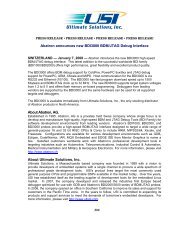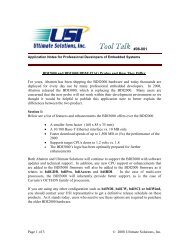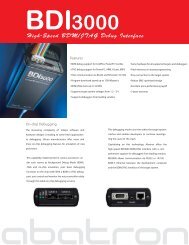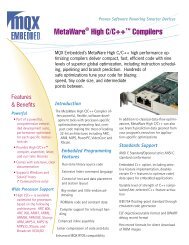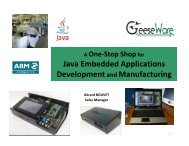STM32 Journal - Digikey
STM32 Journal - Digikey
STM32 Journal - Digikey
Create successful ePaper yourself
Turn your PDF publications into a flip-book with our unique Google optimized e-Paper software.
<strong>STM32</strong> <strong>Journal</strong><br />
Achieving Ultra-Low-Power Efficiency<br />
for Portable Medical Devices<br />
By Jean J. Labrosse, Founder, CEO and President, Micriµm<br />
Jim Lombard, Application Engineer, STMicroelectronics<br />
The availability of low-cost, fullfeatured<br />
microcontrollers has<br />
created a revolution in the health<br />
industry leading to equipment<br />
migrating from the hospital and<br />
into patients’ homes. Designing<br />
these portable medical devices<br />
presents new challenges for<br />
engineers, such as implementing<br />
precision analog processing<br />
requiring complex calculations<br />
and creating a system that is<br />
simple and comfortable to operate<br />
even for physically-challenged<br />
users. In addition, these devices<br />
have to be able to run as long as<br />
possible without having to change<br />
or recharge batteries, even after<br />
sitting on a warehouse shelf for up<br />
to 18 months. To meet the unique<br />
requirements of portable medical<br />
devices, developers need an<br />
advanced processor architecture<br />
that combines performance,<br />
ultra-low-power process<br />
technology, low-cost, and<br />
efficient power management and<br />
communications capabilities.<br />
Designing for Medical<br />
Applications<br />
Next-generation medical<br />
equipment is evolving along<br />
two primary paths: sports and<br />
personal health. Both markets<br />
require innovation that enables<br />
portable devices to collect more<br />
run-time data and complete<br />
advanced calculations to create<br />
a comprehensive profile of a<br />
person’s current condition. Within<br />
personal health, developers<br />
also need to understand the<br />
special requirements of emerging<br />
disposable devices.<br />
The portable medical device<br />
market is extremely strong.<br />
Consider that with 8.3% of the<br />
US population suffering from<br />
diabetes, a portable glucose<br />
meter is an essential tool for<br />
individuals who need to monitor<br />
their glucose for conceivably the<br />
rest of their lives. Similarly, an<br />
electrocardiogram (ECG) monitor<br />
enables people at risk for any<br />
number of conditions to record<br />
their ECG waveform at home. In<br />
addition to eliminating the need<br />
for multiple office visits, homebased<br />
testing gives doctors a<br />
more comprehensive patient<br />
history to work with.<br />
Portable handheld medical<br />
devices have a stringent set<br />
of requirements (see Figure 1.)<br />
Given that prospective users can<br />
be from all walks of life, devices<br />
must be as simple to use as<br />
possible, with limited or no setup<br />
required. They also need to be<br />
comfortable to use and operable<br />
even by physically-challenged<br />
users. In general, the display<br />
must be large for ease of reading<br />
and utilize a minimum number of<br />
buttons to avoid confusing users.<br />
Ideally, as many functions as<br />
possible need to be automated<br />
so that users don’t have to be<br />
trained how to use the device.<br />
If the device has a touchscreen,<br />
the GUI must be intuitive<br />
and have a limited number of<br />
〉〉 Easy and simple to operate<br />
〉〉 Large display<br />
〉〉 Minimal number of large<br />
operator buttons<br />
〉〉 Batteries are easy to<br />
change, easy to recharge,<br />
or are sufficient to last<br />
for the operating life of<br />
the device<br />
〉〉 Safe and accurate<br />
operation<br />
〉〉 Low cost<br />
〉〉 Low power<br />
〉〉 Simple connectivity<br />
〉〉 Audio feedback<br />
Figure 1 Common Product Requirements for<br />
Portable Medical Devices<br />
operating modes. Both low cost<br />
and low power consumption<br />
are critical as well, and devices<br />
need to be able to run as long<br />
as possible without having to<br />
change or recharge the battery.<br />
26


